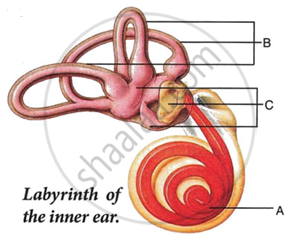Advertisements
Advertisements
प्रश्न
Given below is the diagram of a part of the human ear. Study the same and answer the questions that follow:
 |
- Give the collective biological term for Malleus, locus and Stapes.
- Name the parts labelled A, B and C in the diagram.
- State the functions of the parts labelled 'A' and 'B'.
- Name the audio receptor region present in the part labelled 'A'.
उत्तर
- Ear ossicles
- A - Cochlea
B - Semicircular canals
C - Ear ossicles - The cochlea transmits impulses to the brain via the auditory nerve. Semicircular canals support the body's dynamic homeostasis.
- Organ of Corti, or spiral organ.
संबंधित प्रश्न
Write short notes on the following Ear ossicles
Photoreceptor cells are present in __________.
(A) blind spot
(B) retina
(C) cochlea
(D) cornea
For human ears, the audible range is 20 Hz to 20,000 Hz.
fill in the blanks with suitable functions: Ciliary body and __________.
the biological/technical terms for a thin membrane covering the entire front part of the eye.
Differentiate between the Rods and Cones of Retina (Type of pigment)
Name the following:
The tube which connects the cavity of the middle ear with the throat.
Differentiate between members of the following pair with reference to what is asked in bracket.
Semi-circular canal and cochlea (Senses perceived)
Where is the Semicircular canals located? Briefly mention its function.
With reference to the human ear, answer the question that follow:
Name the part of the ear associated with
(1) static balance
(2) hearing
(3) dynamic balance.
Mention the exact location of the following :
Incus
There are three small bones in the muddle ear – anvil, hammer and stirrup :
(a) Which of these bones is in touch with ear-drum ?
(b) Which of these bones is in touch with oval window ?
Name the following:
The ear ossicle in contact with the oval window of the inner ear.
Mention, if the following statement is True or False
Deafness is caused due to the rupturing of the pinna.
Choose the Odd One Out:
Select the CORRECT match of part of the human ear and its function.
Categorise the following parts under (i) external, (ii) middle and (iii) internal ear.
Ear drum, hammer, pinna, cochlea, anvil, stirrup, eustachian tube, tympanum, oval window, semi-circular canals.
Where are the following located?
Eustachian canal
- Draw a neat and well labelled diagram of the membranous labyrinth found in the inner ear.
- Based on the diagram drawn above in (i), give a suitable term for each of the following descriptions:
- The structure responsible for hearing.
- The sensory cells that help in hearing.
- The membrane-covered opening that connects the middle ear to inner ear.
- The nerves that carry impulses from the ear to the brain.
- The tube which equalises the air pressure on either side of the ear drum.
